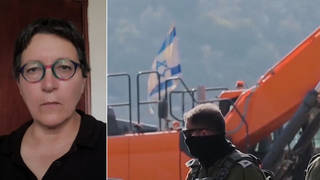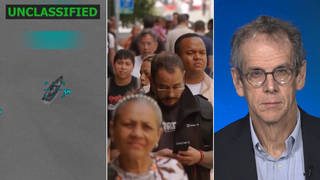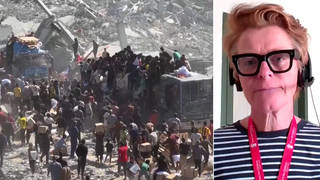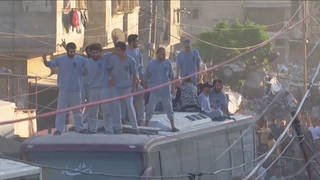
Guests
- Larry Hildeslead attorney in the Panagacos v. Towery case. He is a civil rights attorney with the National Lawyers Guild.
- Glenn Crespoplaintiff in the Panagacos v. Towery case. He is a community organizer in the Bay Area.
More details have come to light showing how the U.S. military infiltrated and spied on a community of antiwar activists in the state of Washington. Democracy Now! first broke this story in 2009 when it was revealed that an active member of Students for a Democratic Society and Port Militarization Resistance was actually an informant for the U.S. military. The man everyone knew as “John Jacob” was in fact John Towery, a member of the Force Protection Service at Fort Lewis. He also spied on the Industrial Workers of the World and Iraq Veterans Against the War. A newly made public email written by Towery reveals the Army informant was building a multi-agency spying apparatus. The email was sent from Towery using his military account to the FBI, as well as the police departments in Los Angeles, Portland, Eugene, Everett and Spokane. He wrote, “I thought it would be a good idea to develop a leftist/anarchist mini-group for intel sharing and distro.” Meanwhile, evidence has also emerged that the Army informant attempted to entrap at least one peace activist, Glenn Crespo, by attempting to persuade him to purchase guns and learn to shoot. We speak to Crespo and his attorney Larry Hildes, who represents all the activists in the case.
Transcript
AMY GOODMAN: More details have come to light showing the U.S. military infiltrated and spied on a community of antiwar activists in the state of Washington and beyond. Democracy Now! first broke the story in 2009 that an active member of Students for a Democratic Society and Port Militarization Resistance was actually an informant for the U.S. military. At the time, Port Militarization Resistance was staging nonviolent actions to stop military shipments bound for Iraq and Afghanistan. The man everyone knew as “John Jacob” was in fact John Towery, a member of the Force Protection Service at Fort Lewis. He also spied on the Industrial Workers of the World and Iraq Veterans Against the War. The antiwar activist Brendan Maslauskas Dunn helped expose John Towery’s true identity as a military spy. In 2009, Dunn spoke on Democracy Now!
BRENDAN MASLAUSKAS DUNN: After it was confirmed that he was in fact John Towery, I knew he wouldn’t call me, so I called him up the day after. This was this past Thursday. And I called him up; I said, “John, you know, what’s the deal? Is this true?” And he told me; he said, “Yes, it is true, but there’s a lot more to this story than what was publicized.” So he wanted to meet with me and another anarchist in person to further discuss what happened and what his role was.
So, when I met him, he admitted to several things. He admitted that, yes, he did in fact spy on us. He did in fact infiltrate us. He admitted that he did pass on information to an intelligence network, which, as you mentioned earlier, was composed of dozens of law enforcement agencies, ranging from municipal to county to state to regional, and several federal agencies, including Immigration Customs Enforcement, Joint Terrorism Task Force, FBI, Homeland Security, the Army in Fort Lewis.
So he admitted to other things, too. He admitted that the police had placed a camera, surveillance camera, across the street from a community center in Tacoma that anarchists ran called the Pitch Pipe Infoshop. He admitted that there were police that did put a camera up there to spy on anarchists, on activists going there.
AMY GOODMAN: That was Brendan Maslauskas Dunn speaking in 2009 on Democracy Now! He’s now a plaintiff in a lawsuit against John Towery, the military and other law enforcement agencies.
Since 2009, there have been numerous developments in the case. A newly made public email written by Towery reveals the Army informant was building a multi-agency spying apparatus. The email was sent by Towery using his military account. It was sent to the FBI as well as the police departments in Los Angeles, in Portland, Eugene, Everett and Spokane, Washington. He wrote, quote, “I thought it would be a good idea to develop a leftist/anarchist mini-group for intel sharing and distro.” Towery also cites “zines and pamphlets,” and a “comprehensive web list” as source material, but cautions the officials on file sharing becase, quote, “it might tip off groups that we are studying their techniques, tactics and procedures,” he wrote. The subject of the email was “Anarchist Information.”
Meanwhile, evidence has also emerged that the Army informant may have attempted to entrap at least one of the peace activists by attempting to persuade him to purchase guns and learn to shoot.
We’re joined now by two guests. Glenn Crespo is a community organizer in the Bay Area who used to live in Washington state, one of the plaintiffs in the lawsuit against the military and other agencies. He’s joining us from Berkeley. And with us in Seattle, Washington, longtime attorney Larry Hildes, who represents the activists in the case.
The Joint Base Lewis-McChord Public Affairs Office declined to join us on the program, saying, quote, “Because this case is still in litigation we are unable to provide comment.”
Let’s go first to Washington state, to Larry Hildes. Can you talk about the latest developments in this case, and what has just come out?
LARRY HILDES: Sure. Good morning, Amy. It’s interesting. What came out did not come out from this case. It came out from a Public Records Act request from a different client of ours who was arrested in an anti-police-brutality march and falsely charged with assaulting an officer, that the civil case is coming to trial in a couple weeks. He put in a Public Records Act request because he was active with PMR and was concerned that he had been targeted, and he was then subject to a number of citations and arrests.
And, yeah, the Army’s investigative reports claimed that, well, there may have been some rules broken, but Towery was doing this off the job in his off-hours, unpaid, for the sheriff—for the Pierce County Sheriff’s Office and the fusion center. Here he is at his desk, 10:00 in the morning, using his military ID, his military email address, and identifying himself by his military titles, writing the law enforcement agencies all over the country about forming this mini-group to target and research anarchists and leftists, and it’s coming out of what’s called the DT Conference that the State Patrol was hosting here in Washington, Domestic Terrorism Conference. They created a book for this conference based on information largely from Towery that included Brendan Dunn and one of our other plaintiffs, Jeff Berryhill, and two other activists with PMR, listed them as domestic terrorists and a violent threat because of their—basically, because they were targeted by Towery and because of their activism and their arrests for civil disobedience. So, he’s taking something he created, labeling these people as terrorists, going to a conference with this information, and saying, “We should disseminate this and work on this more broadly.”
It also puts the lie to Towery’s claim and his supervisor Tom Rudd’s claim that Towery was simply working to protect troop movements from—between Fort Lewis and the public ports of Stryker vehicles going to the occupations in Iraq and Afghanistan. They’re not shipping out of L.A. They’re not shipping out of Portland or Eugene. And they’re not—none of these are agencies that are directly involved in protecting military shipments from Fort Lewis. So it’s clear there’s a much larger agenda here.
And we’ve seen that in some other ways. There are extensive notes that we’ve received of Towery’s spying on a conference of the Evergreen State College in Olympia about tactics for the protests at the DNC in Denver in '08, Republican—Democratic National Convention, and the Republican National Convention in St. Paul in ’08, and who was going to do what, the red, yellow and green zones, and specifically what was going to happen on the Monday of the convention. And it was the RNC Welcome Committee, which then got raided and became the RNC 8—claimed that they were planning acts of terrorism, which were in reality acts of nonviolent civil disobedience. So this goes way beyond Fort Lewis and PMR, and there's a full—there seems to be a much larger agenda, as we’ve seen in other places, of nonviolent activism equals terrorism equals anarchism equals justification for whatever spying or law enforcement action we want to take.
AMY GOODMAN: I want to—
LARRY HILDES: And obviously this is not—sorry, go ahead, Amy.
AMY GOODMAN: I want to read from your lawsuit. You write, quote, “In addition to the Army, Coast Guard, and Olympia Police Department, the following agencies are known to have spied on, infiltrated, or otherwise monitored the activities of PMR and/or related or associated activists: Thurston County Sheriff’s Office, Grays Harbor Sheriff’s Office, Pierce County Sheriff’s Office, Tacoma Police Department, Lakewood Police Department, Ft. Lewis Police Department, 504th Military Police Division, Aberdeen Police Department, The Evergreen State College Police Department, the Lacey Police Department, the [Tumwater] Police Department, the Seattle Police Department, the King County Sheriff’s Office, Immigration and Customs Enforcement, the Federal Protective Service, other Divisions of the Department of Homeland Security, Naval Investigative Services, Air Force Intelligence (which has created a special PMR SDS taskforce at McGwire Air Force Base in New Jersey), The Federal Bureau of Investigation, and the Seattle Joint Terrorism Taskforce, as well as the previously discussed civilian employees of the City of Olympia. This list is likely incomplete,” you write. That is a very extensive list, Larry Hildes.
LARRY HILDES: It is. And it turns out it is incomplete. And those were all agencies that we had documents obtained from Public Records Act requests showing that they were directly involved. So now we’re finding out there’s more agencies. The Evergreen State College was giving regular reports to the State Patrol, to the Thurston County Sheriff’s Office and to Towery and Rudd about activities of SDS on campus at Evergreen. And there’s an extensive discussion about the conference about the DNC and RNC protests and that the chief of police is the source for the information. But, yeah, now we’ve got L.A. This gets bizarre. And we received 9,440 pages of sealed documents from the Army as a Christmas present on December 21st that—that I can’t even talk about, because they insisted that everything was privileged. It was supposed to be privileged as to private information and security information, but it’s everything, all kinds of emails. So, yeah, I mean, it starts out sounding very encompassing, and we’re finding out we were conservative about what agencies were involved.
AMY GOODMAN: I wanted to bring Glenn Crespo into this conversation, a Bay Area community organizer. You were the peace activist who John Towery, you say, attempted to persuade you to purchase guns, to learn to shoot. How did you meet him, and what happened when he tried to get you to do this?
GLENN CRESPO: Well, this kind of relationship spanned over a two-, maybe two-and-a-half-year period of time. I first met him at a weapons symposium demonstration in Tacoma, Washington, in downtown Tacoma. I didn’t introduce myself to him at that point, but I saw him there. He came out—he actually came out of the symposium, and this was a conference where Lockheed Martin and all these other weapons manufacturers and distributors were showing their wares. He came out of that, and it appeared to me as if other activists in Olympia had already become friends with them. He was very friendly with them, they were very friendly with him. That was the first time I saw him. That was in mid-2007. Not long after that, he organized a Tacoma PMR meeting, and I wasn’t really involved—
AMY GOODMAN: Port Militarization Resistance.
GLENN CRESPO: Yeah, exactly. And I wasn’t very involved in that, but I did get the mass email. So I figured, because I lived in Tacoma, I might as well go check it out. He was the first person there. I was the second person there. He introduced himself. I introduced myself. And he asked me about a poster that he had made regarding an upcoming demonstration, and he said he was going to bring it to the group and see if we could get consensus on whether or not it was OK if he put it up. And I told him that—I looked at the poster and said, you know, “This is pretty general.” There’s no particular reason I really think that he has to get consensus on whether or not he can put a poster up that’s kind of basically just time and place and description of the event. And that was the first time I met him.
He later on used that conversation as a way to boost our rapport between each other, when he said that he thought that that conversation was really profound to him, that he believed that it was interesting that I kind of wanted to—or suggested that he bypass some sort of consensus process regarding this poster, so that he can just do—you know, that he could do what he wants. You know, he could put the poster up if he wants to. That was very interesting. I realized that in retrospect, that that was a way that he tried to broaden or expand upon our friendship in the beginning.
AMY GOODMAN: And then, where did the guns come in?
GLENN CRESPO: Probably within the six to seven months after meeting him, so late—late 2007. He had started coming to events at the house I was living at in Tacoma. We were doing—we did a lending library. And we were doing a lot of organizing regarding the Tacoma Immigration and Customs detention center, so the ICE detention center. He would go to those meetings. He would come over for potlucks. So both public and private events, he kind of worked his way in as a friend.
He produced handgun to me in our kitchen, just between he and I. He carried it in his side pocket. He said he always carried a handgun on him. And he emptied it. He put the magazine out. He cleared the chamber, and he handed it to me. And he said he always carries one on him. And that, that was the first time he really talked about guns with me. And I was caught off guard, because at the time I was in my early twenties. I had never held a—I don’t even think I had seen a handgun, really, like that before. And that was kind of the beginning of him starting to talk more about guns. And he said—he had said that if we ever wanted to go shooting, being me and my friends, or myself in particular, that he would take us shooting, or, you know, he knows where all the gun shows are at, so we could go to gun shows if—you know, if we’re interested. And then, later on, these things did happen, when he prompted myself and others to go to the Puyallup Gun Show and purchase—purchase a rifle. And then, that went into going to shooting ranges that he was already a member of. He would drive us to all of these things, take us to these shooting ranges.
And this seemed fairly innocuous to me, in the beginning. I mean, Washington is a pretty gun-owner-friendly state. It didn’t—it didn’t really surprise me, because he wasn’t saying anything crazy or really implying anything crazy at that point. But about a year into that, there was a significant shift in his personality. Whereas in the beginning he was very optimistic and very—seemed very hopeful and kind of seemed lonely—I mean, he was, you know, in his early forties, early to mid-forties. He primarily surrounding himself with people who were in their early twenties. And he just came off as if he was kind of a sweet, harmless guy and was kind of lonely and wanted to hang out with people that he felt like he had something in common with, as far as his ideas went. But like I said, into a year into that relationship, he started to become a little bit more sinister and dark in his demeanor, in his—the things he would talk about.
And this continued to go into him giving myself and another friend a set of documents that were military strategy documents, and he said that he—he suggested that “we,” whatever that meant, use those documents in “our actions.” And these were documents on how to properly execute military operations. And then, following that, he showed people at my house, including myself, how to clear a building with a firearm. And these things were prompted by him. He would basically say, “Hey, do you—you know, check this out. Look, I could explain this stuff.” And he would just go into it, on how to, for example, in this case, clear a building with a firearm. So he had a mock—you know, he would hold a rifle up, or a make-believe rifle, and clear—stalk around the lower levels of our house and up the stairwell, all the way up the second stairwell into the attic, and the whole time talking about how he would—you know, how he was clearing corners and checking angles and all this stuff that nobody particularly had any interest in.
And around the same time, he had, you know, conversations with me about how he believed that anarchists were very similar to fascists, in a—almost in a positive light, where he was saying that they both don’t care about the law and don’t use the law to get what they need or what they want, and that he believed that the only way anarchism or anarchy would ever work, in his words, would be if five billion people died. So this is kind of in his—in the midst of his weird, sinister behavior that started to happen, that I thought that he was depressed. I thought that he was basically going through some sort of like maybe existential crisis, or maybe he was fed up with things. I wasn’t really sure. He always talked about him having issues at the house—at his home. He had implied that his wife was concerned that he was cheating on her, and that’s why we could never go to his house, because his wife didn’t like us, his other friends, or whatever.
He submitted an article in the same—like the last—you know, that last half of the time that I knew him as a friend. He submitted an article to a magazine that I was editor of in early 2009, that was written from the perspective of 9/11 hijackers. And I remember this very specifically, because he gave me a copy, a physical copy, when we were on our way to go get coffee. And I remember reading it, and probably about a quarter of the way through realizing I didn’t even feel comfortable touching it, like touching the physical document with my hands. It was the weirdest thing in the world, because it was kind of—it was basically implying—or seeming sympathetic with the 9/11 hijackers. And he wanted me to publish this in his—in the next issue of the magazine I was editor of. So I just—I actually—because he was being so forceful, I just didn’t do the magazine again. That first issue was the last issue. And once he submitted that paper, I didn’t publish it ever again.
AMY GOODMAN: Let me ask your lawyer, Larry Hildes, is this entrapment, I mean, when you’re talking about this whole progression that Glenn Crespo went through with the man he thought was named John Jacob, who in fact is John Towery, working at Fort Lewis? He’s military personnel.
LARRY HILDES: I think, absolutely, it was an attempted entrapment. He went step by step. He misjudged our folks. He thought our—he correctly saw that our folks were angry and upset about what was going on, but misjudged them. It feels like we could have ended up with a Cleveland Five or an 803 situation very easily, if he had had his way. Fortunately, our folks’ reaction was: “This is really weird and creepy. Get away from me.” And it speaks to how little he understood the nature of the antiwar movement and how little he understood people’s actual commitment to nonviolent action, to not seeing the troops themselves as the enemies—
AMY GOODMAN: Larry—
LARRY HILDES: —but seeing the war—yeah, I’m—yeah, go ahead.
AMY GOODMAN: Larry Hildes, we don’t have much time, but I just want to ask about Posse Comitatus and the laws that separate the military—I mean, they’re not supposed to be marching through the streets of the United States.
LARRY HILDES: Yeah, right.
AMY GOODMAN: What about this issue of investigating? And how far and extensive is this infiltration campaign, where you put in people, they change their names, and they try to entrap or they change the nature of what these actions are?
LARRY HILDES: I think they crossed the line. They claim they’re allowed to do some level of investigative work to protect military activities, military shipments. But entrapping people—attempting to entrap people into conspiracies where they can get charged with major felonies they had no intention of committing, dealing with law enforcement agencies around the country to keep tabs on activists, following them to protests in Denver and St. Paul that have absolutely nothing to do with military shipments, they crossed the line into law enforcement, into civilian law enforcement.
And they did so quite knowingly and deliberately, and created this cover story that Towery was working for the fusion center, reporting to the sheriff’s office, not doing this during his work time, because they were well aware—in fact, he got paid overtime for attending the RNC, DNC conference at Evergreen, by the Army. So the Army was expressly paying him to monitor, disrupt and destroy these folks’ activism and their lives. I mean, we had—at one point, Brendan Dunn had four cases at the same time in four counties, because they kept stopping him. Seven times he got arrested or cited; Jeff Berryhill several times; Glenn Crespo. People would get busted over and over and over. Towery was attending their personal parties, their birthday parties, their going-away parties, and taking these vicious notes and passing them on about how to undermine these folks, how to undermine their activities, how to destroy their lives. This is way into Posse Comitatus. This is way beyond any legitimate military role.
And it’s exactly why Posse Comitatus exists. The job of the military, as they see it, is to seek out the enemy and destroy them, neutralize them. When the enemy is nonviolent dissenters and the First Amendment becomes the enemy, as Chris Pyle, our expert, who was the investigator for the Church Committee, put it—the First Amendment, the Fourth Amendment are an inconvenience to the Army; they ignore them; they’re not sworn to uphold them in the same way—it becomes a very dangerous situation. And yes, they are way over into illegal conduct. They’re into entrapment operations. They’re into trying to silence dissent against them, and apparently much larger. This case just keeps getting bigger as we go. And we’re set for trial, I should say, on June 2nd—
AMY GOODMAN: And we will continue to cover this.
LARRY HILDES: —at this point.
AMY GOODMAN: I want to thank you both for being with us. Larry Hildes, lead attorney representing the antiwar activists spied on by the military, civil rights attorney with the National Lawyers Guild, speaking to us from Seattle, Washington. And Glenn, thank you so much for being with us. Glenn Crespo is a plaintiff in the lawsuit, a community organizer in the Bay Area of California.
This is Democracy Now!, democracynow.org, The War and Peace Report. When we come back, spies in the movement. We’re going to go back some time to the civil rights movement. Stay with us.












Media Options